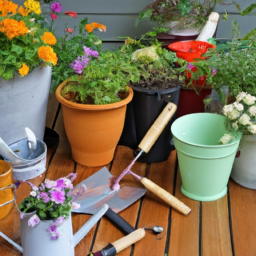Start Container Gardening How-To Guide
How To Start Container Gardening
How To Start Container Gardening
Container gardening allows people to explore their green-fingered potential, develop their own greenspaces, and to make creative use of their environment. It's also an extremely versatile activity, with potential applications in any outdoor or indoor space. In this article, we'll explore the basics of container gardening, look at some of its benefits, and provide an overview of the steps involved for those wishing to start their own project.
Choosing Containers and Plant Types
One of the fun things about container gardening is that you can customize your choices to suit your desired aesthetic, and you're not tied to any one style. You could choose a few large metal containers like oil drum planters, or you could pick several small clay pots and arrange them in a miniature rockery or cacti garden. Just make sure that the containers you choose have drainage holes in the bottom so that your plants don't get waterlogged.
As for what type of plant to use, there's a huge variety you can choose from. Herbs are a popular choice, but you could also look at vegetables, wildflowers, perennials, succulents, or even carnivorous plants.
Location
When considering where to locate your container garden, you'll need to consider the specific needs of your chosen plants. Some prefer full sun, while others will require more shade, so you should keep this in mind.
If you're looking for a low-maintenance garden, you may want to put your containers in a position where they are easy for you to access so that you can regularly check on your plants. If you're creating an outdoor garden, make sure that the containers are not exposed to strong winds, as this can be damaging.
Soil Type
The next step is to decide on the type of soil to use. The general rule is the lighter the soil, the better, as this helps with drainage. You should avoid clay soils, as they can be too dense and can lead to root rot.
When it comes to pre-made soils, look for those designed for containers and raised beds. You can even buy pre-mixed soils that are tailored to specific types of plants.
Top of The Soil
Once you've added the soil, you may want to add a layer of mulch, such as compost or shredded bark, to the top. This will help your plants retain moisture and reduce weeds.
Watering
When it comes to watering, you'll need to familiarize yourself with each plant's needs. Some may require daily sprinkling, while others may only need occasional watering. When you are irrigating, use a hose or watering can and take care not to drown the plants.
Fertilizing
Organic fertilizers are a great way to give plants a boost of nutrients and help them to grow. It's generally a good idea to fertilize your plants every two weeks, although you should check the specific instructions for each plant to ensure that you are giving them the right levels of nutrients.
Pest and Disease Control
The same goes for pests and diseases. Container gardens tend to be more susceptible to these, so it's best to keep an eye out for any signs. Physical removal is often the best way to tackle unwanted pests, and keeping your plants healthy with adequate fertilization, light, water, and air circulation can help to reduce the chances of any disease taking hold.
Final Word
Container gardening is a great way to explore your inner green thumb and make the most of any space. Whether you want to create a herb garden, a vegetable patch, or an exotic cacti display, there's something for everyone. As long as you select the right containers, choose your plants wisely and care for them properly, you're likely to have a thriving garden before you know it.

Previous Page
Next Page
